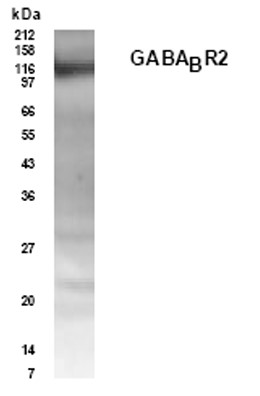Anti-GABABR2 Antibody (56311)
$376.00
SKU: 56311
Categories: Antibody Products, Neuroscience and Signal Transduction Antibodies, Products
Overview
Product Name Anti-GABABR2 Antibody (56311)
Description Anti-GABA (B)R2 Rabbit Polyclonal Antibody
Target GABABR2
Species Reactivity Human
Applications WB
Host Rabbit
Clonality Polyclonal
Immunogen Synthetic peptide corresponding to aa 42-54 (TRGAPRPPPSSPP) of the rat GABABR2 subunit.
Properties
Form Liquid
Concentration 1.0 mg/mL
Formulation PBS, pH 7.4, 0.02% sodium azide.
Buffer Formulation Phosphate Buffered Saline
Buffer pH pH 7.4
Buffer Anti-Microbial 0.02% Sodium Azide
Format Purified
Purification Purified by Protein A affinity chromatography
Specificity Information
Specificity This antibody recognizes the human and rat GABABR2 subunit.
Target Name γ-aminobutyric acid type B receptor subunit 2
Target ID GABABR2
Uniprot ID O75899
Alternative Names GABA-B receptor 2, GABA-B-R2, GABA-BR2, GABABR2, Gb2, G-protein coupled receptor 51, HG20
Gene Name GABBR2
Sequence Location Cell membrane, Cell junction, synapse, postsynaptic cell membrane
Biological Function Component of a heterodimeric G-protein coupled receptor for GABA, formed by GABBR1 and GABBR2 (PubMed:9872316, PubMed:9872744, PubMed:15617512, PubMed:18165688, PubMed:22660477, PubMed:24305054). Within the heterodimeric GABA receptor, only GABBR1 seems to bind agonists, while GABBR2 mediates coupling to G proteins (PubMed:18165688). Ligand binding causes a conformation change that triggers signaling via guanine nucleotide-binding proteins (G proteins) and modulates the activity of down-stream effectors, such as adenylate cyclase (PubMed:10075644, PubMed:10773016, PubMed:24305054). Signaling inhibits adenylate cyclase, stimulates phospholipase A2, activates potassium channels, inactivates voltage-dependent calcium-channels and modulates inositol phospholipid hydrolysis (PubMed:10075644, PubMed:9872744, PubMed:10906333, PubMed:10773016). Plays a critical role in the fine-tuning of inhibitory synaptic transmission (PubMed:9872744, PubMed:22660477). Pre-synaptic GABA receptor inhibits neurotransmitter release by down-regulating high-voltage activated calcium channels, whereas postsynaptic GABA receptor decreases neuronal excitability by activating a prominent inwardly rectifying potassium (Kir) conductance that underlies the late inhibitory postsynaptic potentials (PubMed:9872316, PubMed:10075644, PubMed:9872744, PubMed:22660477). Not only implicated in synaptic inhibition but also in hippocampal long-term potentiation, slow wave sleep, muscle relaxation and antinociception (Probable). {PubMed:10075644, PubMed:10328880, PubMed:15617512, PubMed:18165688, PubMed:22660477, PubMed:24305054, PubMed:9872316, PubMed:9872744, ECO:0000305}.
Research Areas Neuroscience
Background The GABAB receptor is the first discovered G-protein-coupled receptor whose function requires two subunits, R1 and R2, to form a functional receptor. The R1 subunit extracellular domain binds GABA, and the R2 subunit functions in G-protein activation.
Application Images


Description Immunoblotting: use at 1:250 – 1:1,000 dilution. A band of ~105kDa is detected. Western blot analysis of GABABR2 in rat brain lysate with #56311 at a 1:500 dilution.
Handling
Storage This antibody is stable for at least one (1) year at -20°C. Avoid multiple freeze-thaw cycles.
Dilution Instructions Dilute in PBS or medium which is identical to that used in the assay system.
Application Instructions Immunoblotting: use at 1:250 - 1:1,000 dilution. A band of ~105kDa is detected.
References & Data Sheet
Data Sheet  Download PDF Data Sheet
Download PDF Data Sheet
 Download PDF Data Sheet
Download PDF Data Sheet


